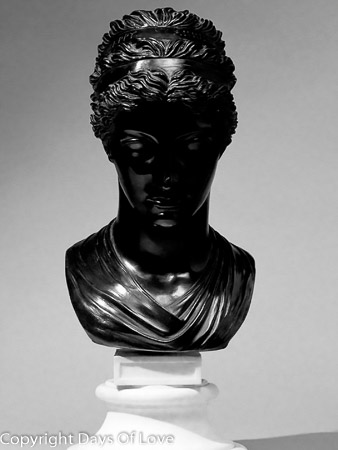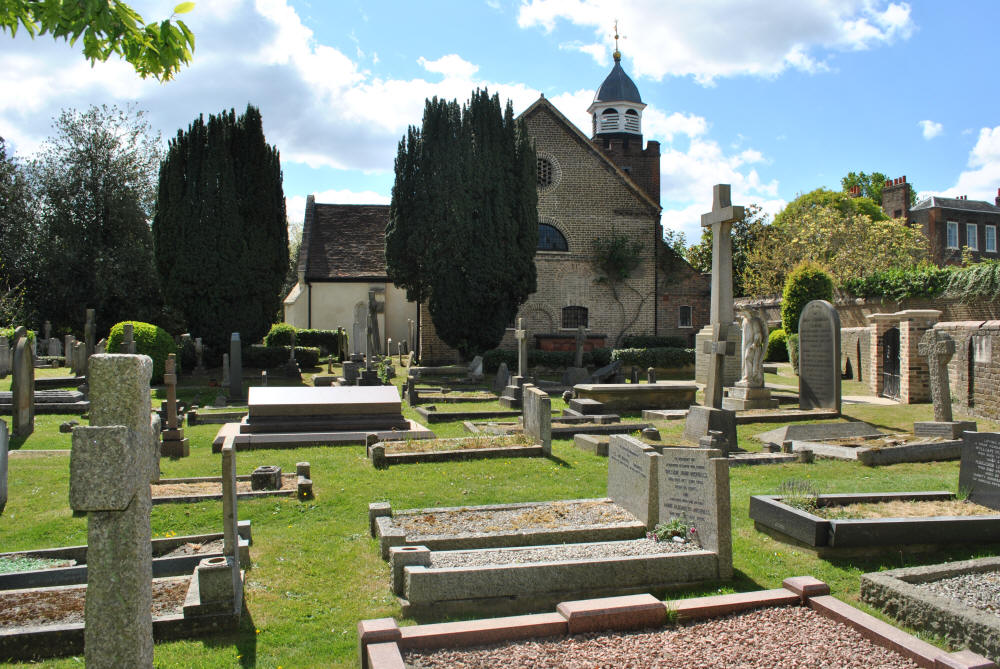Partner Anne Seymour Damer
Queer Places:
Strawberry Hill House, 268 Waldegrave Rd, Twickenham TW1 4ST, UK
St Peter, Church Lane, off Petersham Road, Richmond TW10 7AA, Regno Unito
 Mary
Berry (16 March 1763 – 20 November 1852) was an English non-fiction writer
born in Kirkbridge,
North Yorkshire. She is best known for her letters and journals, namely
Social Life in England and France from the French Revolution, published in
1831, and Journals and Correspondence, published after her death in
1865.[1]
Berry became notable through her association with close friend
Horace Walpole, whose literary collection she, along with her sister and
father, inherited.[2]
The renowned sculptor Anne
Seymour Damer was passionately in love with Mary Berry, who lived
with her sister in Twickenham. Mary never allowed Anne’s advances to
stray beyond the preliminaries and kept her suitor at arm’s length, as a
friend only. Anne
Seymour Damer was the subject of a number of political satires in
the XVIII century. After her husband's death, she developed a close
friendship with
Mary Berry
and her home in Strawberry Hill became associated with a sapphic set
including the actresses Kitty Clive and
Elizabeth Farren.
One satire, entitles A Sapphic Epistle, by Jack Cavendish, referred to a
Mrs D...r and claimed: Strawberry Hill at once doth prove, Taste,
elegange, and Sapphic love, In gentle Kitty. Another referred to
Elizabeth Farren before her marriage to Lord Derby, observing: superior
to the influence of MEN, she is supposed to feel more exquisite delight
from the touch of the cheek of Mrs D...r, than the fancy of any
novelties which the wedding night can promise with such a partner as his
lordship.
Mary
Berry (16 March 1763 – 20 November 1852) was an English non-fiction writer
born in Kirkbridge,
North Yorkshire. She is best known for her letters and journals, namely
Social Life in England and France from the French Revolution, published in
1831, and Journals and Correspondence, published after her death in
1865.[1]
Berry became notable through her association with close friend
Horace Walpole, whose literary collection she, along with her sister and
father, inherited.[2]
The renowned sculptor Anne
Seymour Damer was passionately in love with Mary Berry, who lived
with her sister in Twickenham. Mary never allowed Anne’s advances to
stray beyond the preliminaries and kept her suitor at arm’s length, as a
friend only. Anne
Seymour Damer was the subject of a number of political satires in
the XVIII century. After her husband's death, she developed a close
friendship with
Mary Berry
and her home in Strawberry Hill became associated with a sapphic set
including the actresses Kitty Clive and
Elizabeth Farren.
One satire, entitles A Sapphic Epistle, by Jack Cavendish, referred to a
Mrs D...r and claimed: Strawberry Hill at once doth prove, Taste,
elegange, and Sapphic love, In gentle Kitty. Another referred to
Elizabeth Farren before her marriage to Lord Derby, observing: superior
to the influence of MEN, she is supposed to feel more exquisite delight
from the touch of the cheek of Mrs D...r, than the fancy of any
novelties which the wedding night can promise with such a partner as his
lordship.
Berry was born in Kirkbridge, Yorkshire on 16 March 1763. Her younger
sister Agnes, who proved to be Mary's closest confidant during her life, was
born fourteen months later on 29 May 1764.
Their father, Robert Berry, was the nephew of a successful Scottish
merchant named Ferguson. Robert received £300,000 in mid-life and bought an
estate at Raith in Fifeshire. As the older son of Ferguson's sister, he began
working at his uncle's counting-house in Broad Street, Austin Friars. In 1762,
he married his distant cousin, a Miss Seaton. After giving birth to Mary and
Agnes, she and their third child died three years later, in 1767, during
childbirth.

Strawberry Hill House, Twickenham

St. Peter's, Petersham
Following their mother's death, the two girls were cared for by their
grandmother, Mrs. Seaton, at Askham in Yorkshire. They were moved to the
College House in Chiswick in 1770. After their governess at
Chiswick
married in 1776, the two girls were self-educated. Their religious instruction
consisted of Mary reading aloud a
Psalm to her grandmother every morning, and one of the Saturday papers
from the
Spectator every Sunday.
In 1781, the uncle, Mr Ferguson, died at age 93. He left money to both
Robert and his younger brother, William. In 1783, Robert Berry and his two
young daughters travelled abroad to Holland, Switzerland and Italy. Mary
assumed the role of protective mother to her sister, and a guide and monitor
to her father.
Mary Berry began writing Journals and Correspondence while in
Florence
in 1783, though she would not complete the writing until 70 years later. After
a long stay in
Italy, her tour was completed by a return home through
France to
England in
June 1786.
Berry and her sister Agnes had a remarkable association with
Horace Walpole. They first met him in the winter of 1788, when he was then
more than 70 years old. A letter he wrote in October 1788 related how: “he had
just then willingly yielded himself up to their witcheries on meeting them at
the house of his friend Lady Herries, wife of the banker in St. James's
Street”. Walpole developed a deep fondness for the two girls, lavishing
them with endearments and compliments. In his letters, Walpole spoke of both
in terms of the strongest affection and endearment, in one instance addressing
them as his "twin wives". He wrote books solely for their pleasure and
dedicated other writings to them. It was solely for their amusement that he
wrote his Reminiscences of the Courts of
George I and
II (1789). He established the sisters at
Teddington in 1789, and two years later, in 1791, he prevailed upon them
to move into Little Strawberry Hill, a house previously known as Cliveden, the
abode of his friend
Kitty
Clive, the famous actress. They lived there for many years.
George Walpole, died in 1791 and his titles and estate were passed to his
uncle Horace. Horace became the 4th Earl of Orford. "There is a tradition
handed down by Lord Lansdowne", says the
Edinburgh
Review, "that he (Walpole) was ready to go through the formal ceremony
of marriage with either sister, to make sure of their society and confer rank
and fortune on the family - he had the power of charging the Orford estate
with a jointure of £2,000 a year.”
This did not occur.
In 1779, Mary's hand had been sought in marriage by a Mr Bowman and she
wrote long afterwards that she had "suffered as people do" at sixteen "from
what, wisely disapproved of, I resisted and dropped."
General
Charles O'Hara, governor of
Gibraltar,
had met Berry in 1784 in Italy, and was engaged to her before leaving England
for Gibraltar in November 1795. Berry had been reluctant to leave England
immediately as his bride. This led to their gradual estrangement and
ultimately the breaking off of their engagement at the end of April 1796.
Walpole died on 2 March 1797[4]
and left both women £4,000 and Little Strawberry Hill House, where they lived.
He also bequeathed to Robert, Mary, and Agnes Berry his printed works and a
box containing manuscripts, to be published at their discretion.
In 1802 Berry went to Paris and, during her stay, she was presented to
Napoleon in the palace of the Tuileries. Returning to France with her sister
and father later in the year, she went on to Nice, Switzerland and Germany,
returning England in September 1803.
During her life Berry suffered from only one serious illness, a near-fatal
attack of bilious fever in 1825. She died of old age around midnight on 20
November 1852 at age 90.
Her sister, Agnes, had died in January of the same year.[5][6]
Both are buried in the churchyard of
St Peter's Church, Petersham.[7]
My published books:


BACK TO HOME PAGE

- https://en.wikipedia.org/wiki/Mary_Berry_(writer,_born_1763)
- A Lesbian History of Britain: Love and Sex Between Women Since 1500,
Rebecca Jennings, Greenwood World Pub., 2007
- Rossini, Gill. Same Sex Love 1700-1957: A History and Research Guide .
Pen and Sword. Edizione del Kindle.
- Rupp, Leila J.. Sapphistries (Intersections) (p.120). NYU Press.
Edizione del Kindle.
 Mary
Berry (16 March 1763 – 20 November 1852) was an English non-fiction writer
born in Kirkbridge,
North Yorkshire. She is best known for her letters and journals, namely
Social Life in England and France from the French Revolution, published in
1831, and Journals and Correspondence, published after her death in
1865.[1]
Berry became notable through her association with close friend
Horace Walpole, whose literary collection she, along with her sister and
father, inherited.[2]
The renowned sculptor Anne
Seymour Damer was passionately in love with Mary Berry, who lived
with her sister in Twickenham. Mary never allowed Anne’s advances to
stray beyond the preliminaries and kept her suitor at arm’s length, as a
friend only. Anne
Seymour Damer was the subject of a number of political satires in
the XVIII century. After her husband's death, she developed a close
friendship with
Mary Berry
and her home in Strawberry Hill became associated with a sapphic set
including the actresses Kitty Clive and
Elizabeth Farren.
One satire, entitles A Sapphic Epistle, by Jack Cavendish, referred to a
Mrs D...r and claimed: Strawberry Hill at once doth prove, Taste,
elegange, and Sapphic love, In gentle Kitty. Another referred to
Elizabeth Farren before her marriage to Lord Derby, observing: superior
to the influence of MEN, she is supposed to feel more exquisite delight
from the touch of the cheek of Mrs D...r, than the fancy of any
novelties which the wedding night can promise with such a partner as his
lordship.
Mary
Berry (16 March 1763 – 20 November 1852) was an English non-fiction writer
born in Kirkbridge,
North Yorkshire. She is best known for her letters and journals, namely
Social Life in England and France from the French Revolution, published in
1831, and Journals and Correspondence, published after her death in
1865.[1]
Berry became notable through her association with close friend
Horace Walpole, whose literary collection she, along with her sister and
father, inherited.[2]
The renowned sculptor Anne
Seymour Damer was passionately in love with Mary Berry, who lived
with her sister in Twickenham. Mary never allowed Anne’s advances to
stray beyond the preliminaries and kept her suitor at arm’s length, as a
friend only. Anne
Seymour Damer was the subject of a number of political satires in
the XVIII century. After her husband's death, she developed a close
friendship with
Mary Berry
and her home in Strawberry Hill became associated with a sapphic set
including the actresses Kitty Clive and
Elizabeth Farren.
One satire, entitles A Sapphic Epistle, by Jack Cavendish, referred to a
Mrs D...r and claimed: Strawberry Hill at once doth prove, Taste,
elegange, and Sapphic love, In gentle Kitty. Another referred to
Elizabeth Farren before her marriage to Lord Derby, observing: superior
to the influence of MEN, she is supposed to feel more exquisite delight
from the touch of the cheek of Mrs D...r, than the fancy of any
novelties which the wedding night can promise with such a partner as his
lordship.


